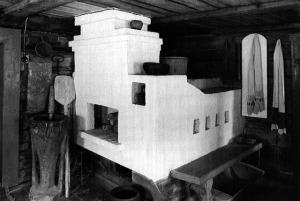Ancient Off-Grid Heater That’s Far Better Than A Wood Stove (Video)
by N.Morgan

Although cheap to fuel, wood fireplaces are not the most efficient hearth appliance in the industry. On the other hand, wood-burning stoves can provide 3x as much heat with 1/3 of the firewood, meaning they are more efficient and offer more heating power than open burning fireplaces.
It’s the most reliable, safe, and efficient way to produce heat with wood. So why do so few homes nowadays have them?
Masonry stoves have been used for centuries — across Scandinavia, France, Germany and Poland. But they were seldom found in Britain and it’s the early British influence on North America that may account for their relative scarcity in the US.
On a fundamental level, a masonry stove is a massive assembly of bricks that is designed to hold and radiate heat produced by a wood fire. When properly designed and built, a masonry stove can continue to radiate heat for up to 20 hours in a well-insulated home after the intense burning of a two-hour fire. On average, though, the two-hour fire will heat a home in winter for eight to 12 hours.
The brickwork in the chimney is designed to circulate the smoke through a system of channels that extract as much heat as possible before the smoke exits the flue. Because an intense fire is used to heat up the masonry, there is little creosote buildup and it produces a very clean fire.
Well-known American author Mark Twain was so impressed with the masonry stove during a trip to Europe that he wrote about it, expressing confusion about why America hadn’t imported the heating style:
“All day long and until past midnight all parts of the room will be delightfully warm and comfortable … Its surface is not hot: you can put your hand on it anywhere and not get burnt. Consider these things. One firing is enough for the day: the cost is next to nothing: the heat produced is the same all day, instead of too hot and too cold by turns … America could adopt this stove, but does America do it? No, she sticks placidly to her own fearful and wonderful inventions in the stove line. The American wood stove, of whatever breed, is a terror. It requires more attention that a baby. It has to be fed every little while, it has to be watched all the time: and for all reward you are roasted half your time and frozen the other half … and when your wood bill comes in you think you have been supporting a volcano. It is certainly strange that useful customs and devices do not spread from country to country with more facility and promptness than they do.”
A side benefit to a masonry stove is the inclusion of an oven in the brickwork. This is another great off-the-grid solution and it works extremely well for baking everything from bread and pizzas to turkeys.
As Twain pointed out, the masonry does not get terribly hot on the surface. Unlike a cast-iron stove that can easily burn you if touched, the brick and stone in a masonry stove radiate heat steadily at a lower temperature. It can still be hot to the touch, but not as hot as a traditional wood-burning stove.
Popular materials used in construction include fire-brick, soapstone, and other types of brick that hold and retain heat well. There are free-standing masonry stoves that you can buy, but they really should be installed by a professional and are sometimes assembled in pieces due to their weight. There also are building codes and necessary safety features that need to be followed because of the high heat generated in the firebox.
Because the masonry stove puts off a consistent heat for hours without great fuss, it is a great asset if you are living without electricity and gas.

References:
Stories Contributed by N. Morgan
Comments
Post a Comment